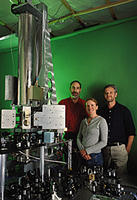Statement on Vice President Cheney's Medical Procedure
This morning (09/24/05), at George Washington Hospital, the Vice President underwent successful, elective, minimally invasive, endovascular repair of arterial aneurysms behind his right and left knees. Small aneurysms were identified behind both knees during the Vice President's annual physical examination in July.
The procedure was performed by a multidisciplinary team led by Dr. Anthony Venbrux, Director of Interventional Radiology, Dr. Jonathan Reiner, Director of the Cardiac Catheterization Laboratory, and Dr. Joseph Giordano, Chairman of Surgery. Joining the team were Dr. Barry Katzen, Director of the Baptist Cardiac and Vascular Institute at Baptist Hospital in Miami and Dr. Peter Gloviczki, Chair of Vascular Surgery at Mayo Clinic.
Using local anesthesia, two overlapping Viabahn stent grafts were implanted in the right popliteal artery. The implanted device consists of a flexible, self-expanding stent covering a thin walled graft composed of polytetrafluoroethylene. Placement of the device in the right knee artery went exceedingly smoothly, and an intraoperative decision was made to repair the aneurysm behind the left knee using a similar technique. The procedure lasted six hours and there were no complications.
Presently, the Vice President is awake, alert, and comfortable. Later this afternoon, the Vice President will be briefed on the impact of Hurricane Rita in Louisiana and Texas, as well as the ongoing federal, state and local response. He will remain in the hospital for up to 48 hours to monitor his recovery and is expected to resume his regular schedule when he is released to home.
# # # For Immediate Release, Office of the Vice President, September 24, 2005
more at Vice President Cheney or Vice President and Cheney or Dick Cheney and arterial aneurysms or Viabahn stent grafts
Monday, September 26, 2005
Statement on Vice President Cheney's Medical Procedure
Sunday, September 25, 2005
The world's best clock, NIST-F1
The improved version of NIST-F1 would neither gain nor lose one second in 60 million years, according to a paper published online Sept. 13 by the journal Metrologia.* NIST-F1 uses a fountain-like movement of cesium atoms to determine the length of the second. The clock measures the natural oscillations of the atoms to produce more than 9 billion "ticks" per second. These results then contribute to the international group of atomic clocks that define the official world time. NIST-F1 has been formally evaluated 15 times since 1999; in its record performance, it measured the second with an uncertainty of 0.53 × 10-15
The improved accuracy is due largely to three factors, according to Tom Parker, leader of the NIST atomic standards research group. First, better lasers, software and other components have made the entire NIST-F1 system much more reliable and able to operate for longer periods of time. Second, the atoms in the cesium vapor are now spread out over a much larger volume of space, reducing the frequency shifts caused by interactions among the atoms. (The formerly round cloud of atoms is now shaped like a short cigar.) Third, scientists are now better able to control magnetic fields within the clock and quantify the corrections needed to compensate for their effects on the atoms.
Improved time and frequency standards have many applications. For instance, ultraprecise clocks can be used to improve synchronization in precision navigation and positioning systems, telecommunications networks, and wireless and deep-space communications. Better frequency standards can be used to improve probes of magnetic and gravitational fields for security and medical applications, and to measure whether "fundamental constants" used in scientific research might be varying over time--a question that has enormous implications for understanding the origins and ultimate fate of the universe. ###
* T.P. Heavner, S.R. Jefferts, E.A. Donley, J.H. Shirley, T.E. Parker. 2005. NIST-F1: Recent improvements and accuracy evaluations. Metrologia (October 2005). Posted online Sept. 13.
Contact: Laura Ost laura.ost@nist.gov 301-975-4034 National Institute of Standards and Technology (NIST) For a high-resolution version of this photo contact inquiries@nist.gov. An additional version of this photo showing just the F1 atomic clock is also available.
more at National Institute of Standards and Technology or NIST and cesium or atomic and lasers or physics









